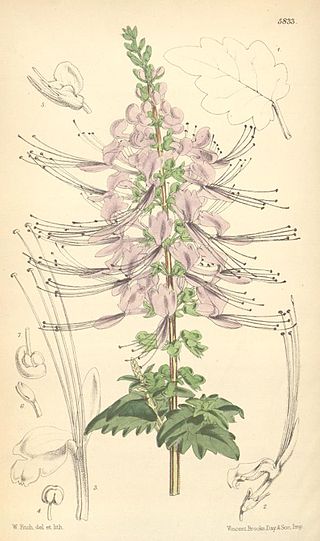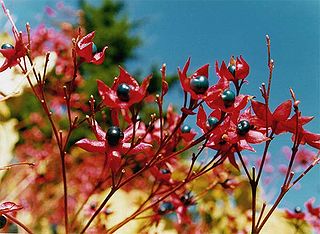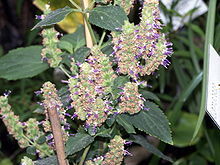
Nepeta is a genus of flowering plants in the family Lamiaceae. The genus name, from Latin nepeta (“catnip”), is reportedly in reference to Nepete, an ancient Etruscan city. There are about 250 species.

Argyreia is a genus of plants in the family Convolvulaceae.

Leucas is a genus of plants in the family Lamiaceae, first described by Robert Brown in 1810. It contains over 200 species, widespread over much of Africa, and southern and eastern Asia with a few species in Queensland and on various islands in the Indian Ocean.

Melissa is a genus of perennial herbs in the Lamiaceae, native to Europe and Asia but cultivated and naturalized in many other places. The name Melissa is derived from the Greek word μέλισσα (mélissa) meaning "honeybee", owing to the abundance of nectar in the flowers. The stems are square, like most other plants in the mint family. The leaves are borne in opposite pairs on the stems, and are usually ovate or heart-shaped and emit a lemony scent when bruised. Axillary spikes of white or yellowish flowers appear in the summer.

Orthosiphon is a genus of plants in the family Lamiaceae native to Africa, Southern Asia and Queensland, with one species (O. americanus) in Colombia. They are herbaceous shrubs which grow to a height of 1.5 m (5 ft). Some Orthosiphon species are popular garden plants because of their flowers, which are white and bluish with filaments resembling a cat's whiskers. In the wild, the plants can be seen growing in forests and along roadsides.

Clerodendrum is a genus of flowering plants formerly placed in the family Verbenaceae, but now considered to belong to the Lamiaceae (mint) family. Its common names include glorybower, bagflower and bleeding-heart. It is currently classified in the subfamily Ajugoideae, being one of several genera transferred from Verbenaceae to Lamiaceae in the 1990s, based on phylogenetic analysis of morphological and molecular data.

Cyanotis is a genus of mainly perennial plants in the family Commelinaceae, first described in 1825. It is native to Africa, southern Asia, and northern Australia.

Ormosia is a genus of legumes. 131 living species, mostly trees or large shrubs, are native to the tropical Americas, from southwestern Mexico to Bolivia and southern Brazil, to southern, southeastern, and eastern Asia, and to New Guinea and Queensland. Most are tropical, while some extend into temperate temperate regions of China. A few species are threatened by habitat destruction, while the Hainan ormosia is probably extinct already.

Vincetoxicum is a genus of plants in the family Apocynaceae. Although the species in Vincetoxicum have sometimes been included in Cynanchum, chemical and molecular evidence shows that Vincetoxicum is more closely related to Tylophora, now included in Vincetoxicum. The generic name means "poison-beater" in Botanical Latin because of the plants' supposed antidotal effects against snakebite.

Flemingia is a genus of plants in the legume family Fabaceae. It is native sub-Saharan Africa, Yemen, tropical Asia, and Australasia. In Asia the species are distributed in Bhutan, Burma, China, India; Indonesia, Laos, Malaysia, Nepal, Pakistan, Papua New Guinea, Philippines, Sri Lanka, Taiwan, Thailand and Vietnam. The genus was erected in 1812.

Elsholtzia is a plant genus in the Lamiaceae. It is widespread across much of temperate and tropical Asia from Siberia south to China, Northeastern India, Indonesia, etc. The genus was named in honour of the Prussian naturalist Johann Sigismund Elsholtz.
- Elsholtzia amurensisProb. - Amur region of Russia
- Elsholtzia angustifolia(Loes.) Kitag. - Korea, Manchuria
- Elsholtzia argyiH.Lév. - southern China, Vietnam
- Elsholtzia beddomeiC.B.Clarke ex Hook.f. - Myanmar, Thailand
- Elsholtzia blanda(Benth.) Benth. - southern China, Himalayas, Indochina, Sumatra, Viet Nam
- Elsholtzia bodinieriVaniot - Guizhou, Yunnan
- Elsholtzia byeonsanensisM.Kim - South Korea
- Elsholtzia capituligeraC.Y.Wu - Tibet, Sichuan, Yunnan
- Elsholtzia cephalanthaHand.-Mazz. - Sichuan
- Elsholtzia ciliata(Thunb.) Hyl. - widespread across Siberia, Russian Far East, China, India, Himalayas, Japan, Korea, Indochina
- Elsholtzia communis(Collett & Hemsl.) Diels - Myanmar, Thailand, Vietnam
- Elsholtzia concinnaVautier - Nepal, Sikkim, Bhutan
- Elsholtzia cyprianii(Pavol.) C.Y.Wu & S.Chow - central + southern China
- Elsholtzia densaBenth. - India, Pakistan, Nepal, Bhutan, Afghanistan, Kyrgyzstan, Tajikistan, Tibet, Xinjiang, China, Mongolia
- Elsholtzia eriocalyxC.Y.Wu & S.C.Huang - southern China
- Elsholtzia eriostachya(Benth.) Benth. - China, Tibet, Himalayas
- Elsholtzia feddeiH.Lév - China, Tibet
- Elsholtzia flavaBenth. - China, Himalayas
- Elsholtzia fruticosa(D.Don) Rehder - China, Himalayas, Tibet, Myanmar
- Elsholtzia glabraC.Y.Wu & S.C.Huang - China
- Elsholtzia griffithiiHook.f - Myanmar, Assam
- Elsholtzia hallasanensisY.N.Lee - Jeju-do Island in Korea
- Elsholtzia heterophyllaDiels - Yunnan, Myanmar
- Elsholtzia hunanensisHand.-Mazz. - southern China
- Elsholtzia kachinensisPrain - southern China, Myanmar, Thailand
- Elsholtzia litangensisC.X.Pu & W.Y.Chen - Sichuan
- Elsholtzia luteolaDiels - Sichuan, Yunnan
- Elsholtzia minimaNakai - Jeju-do Island in Korea
- Elsholtzia myosurusDunn - Sichuan, Yunnan
- Elsholtzia nipponicaOhwi - Japan
- Elsholtzia ochroleucaDunn - Sichuan, Yunnan
- Elsholtzia oldhamiiHemsl. - Taiwan
- Elsholtzia pendulifloraW.W.Sm - Yunnan, Thailand, Vietnam
- Elsholtzia pilosa(Benth.) Benth. - China, Himalayas, Myanmar, Vietnam
- Elsholtzia pubescensBenth. - Java, Bali, Lombok, Timor, Sulawesi
- Elsholtzia pygmaeaW.W.Sm. - Yunnan
- Elsholtzia rugulosaHemsl - southern China, Myanmar, Thailand
- Elsholtzia serotinaKom - northern China, Japan, Korea, Primorye
- Elsholtzia soulieiH.Lév. - Sichuan, Yunnan
- Elsholtzia splendensNakai ex F.Maek. - China, Korea
- Elsholtzia stachyodes(Link) Raizada & H.O.Saxena - Indian Subcontinent, China, Myanmar
- Elsholtzia stauntoniiBenth. - northern China
- Elsholtzia strobilifera(Benth.) Benth. - China, Himalayas, Myanmar
- Elsholtzia winitianaCraib - Yunnan, Guangxi, Laos, Thailand, Vietnam

Anisochilus is a genus in the family Lamiaceae, commonly called as Kapuri first described in 1830. It is native to China, the Indian Subcontinent, and Indochina. Has healing properties that deal with treatment for ailments known as gastric ulcer and helps with dermis issues. Anisochilus also has active properties such as camphor, leutiolin, and apigenin. A new hygrine-like compound has been found within the DNA of this plant.

Gomphostemma is a genus of flowering plants in the mint family, Lamiaceae, first described in 1830. It is native to Southeast Asia, China, and the Indian subcontinent.
- Gomphostemma aborensisDunn - Arunachal Pradesh
- Gomphostemma arbusculumC.Y.Wu - Yunnan
- Gomphostemma callicarpoides(Yamam.) Masam. - Taiwan
- Gomphostemma chinenseOliv. - Fujian, Guangdong, Guangxi, Hainan, Jiangxi, Vietnam
- Gomphostemma crinitumWall. ex Benth. - Indochina, Yunnan, Assam, Bangladesh
- Gomphostemma curtisiiPrain - Malaya, Sumatra, Borneo
- Gomphostemma deltodonC.Y.Wu - Yunnan
- Gomphostemma dolichobotrysMerr. - Sumatra
- Gomphostemma eriocarpumBenth. - southern India
- Gomphostemma grandiflorumDoan ex Suddee & A.J.Paton - Vietnam
- Gomphostemma hainanenseC.Y.Wu - Hainan
- Gomphostemma hemsleyanumPrain ex Collett & Hemsl. - Java, Myanmar
- Gomphostemma heyneanumWall. ex Benth. - southern India
- Gomphostemma hirsutumWalsingham - Sabah
- Gomphostemma inopinatumPrain - Myanmar
- Gomphostemma javanicum(Blume) Benth. - Indochina, Andaman Islands, Borneo, Sumatra, Java, Sulawesi, Bali, Lombok, Timor, Philippines
- Gomphostemma keralensisVivek., Gopalan & R.Ansari. - Kerala
- Gomphostemma laceiMukerjee - Myanmar
- Gomphostemma latifoliumC.Y.Wu - Yunnan, Guangdong
- Gomphostemma leptodonDunn - Guangxi, Vietnam
- Gomphostemma lucidumWall. ex Benth. - Indochina, Assam, Bangladesh, Guangdong, Guangxi, Yunnan
- Gomphostemma mastersiiBenth. ex Hook.f. - Assam, Bangladesh, Thailand
- Gomphostemma melissifoliumWall. ex Benth. - Assam, Bangladesh, Bhutan, Nepal
- Gomphostemma microcalyxPrain - Borneo, Malaya, Sumatra
- Gomphostemma microdonDunn - Yunnan, Laos, Thailand, Vietnam
- Gomphostemma nayariiA.S.Chauhan - Assam
- Gomphostemma niveumHook.f. - Assam, Arunachal Pradesh, Vietnam
- Gomphostemma nutansHook.f. - Assam, Myanmar
- Gomphostemma ovatumWall. ex Benth. - Assam, Bangladesh, Bhutan, Nepal
- Gomphostemma parviflorumWall. ex Benth. - Assam, Bangladesh, Bhutan, Nepal, Yunnan, Indochina, Borneo, Java, Sumatra
- Gomphostemma pedunculatumBenth. ex Hook.f. - Assam, Yunnan, Vietnam
- Gomphostemma pseudocrinitumC.Y.Wu - Guangxi
- Gomphostemma salarkhanianumKhanam & M.A.Hassan - Sylhet District in Bangladesh
- Gomphostemma scortechiniiPrain - Myanmar, Thailand, Malaya
- Gomphostemma stellatohirsutumC.Y.Wu - Yunnan
- Gomphostemma strobilinum Wall. ex Benth. - Bangladesh, Myanmar, Thailand, Vietnam
- Gomphostemma sulcatumC.Y.Wu - Yunnan
- Gomphostemma thomsoniiBenth. ex Hook.f. - Assam
- Gomphostemma velutinumBenth. - Assam, Bangladesh
- Gomphostemma wallichiiPrain - Assam, Myanmar, Thailand
Microtoena is a genus of flowering plants in the mint family, Lamiaceae, first described in 1889. It is native to eastern and southeastern Asia, primarily China.
- Microtoena albescensC.Y.Wu & S.J.Hsuan - Guizhou
- Microtoena bhutanicaStearn - Bhutan
- Microtoena coreanaH.Lév - Korea
- Microtoena delavayiPrain - Sichuan, Yunnan
- Microtoena esquiroliiH.Lév. - Yunnan, Guizhou, Guangxi
- Microtoena griffithiiPrain - Arunachal Pradesh, Bangladesh
- Microtoena insuavis(Hance) Prain ex Briq. - Thailand, Vietnam, Guangdong, Guizhou, Yunnan
- Microtoena longisepalaC.Y.Wu - Sichuan
- Microtoena maireanaHand.-Mazz. - Yunnan
- Microtoena megacalyxC.Y.Wu - Guizhou, Yunnan
- Microtoena miyiensisC.Y.Wu & H.W.Li - Sichuan
- Microtoena mollisH.Lév. - Guizhou, Yunnan, Guangxi
- Microtoena moupinensis(Franch.) Prain - Tibet, Sichuan
- Microtoena muliensisC.Y.Wu - Sichuan
- Microtoena nepalensisStearn - Nepal
- Microtoena omeiensisC.Y.Wu & S.J.Hsuan - Sichuan
- Microtoena patchoulii(C.B.Clarke ex Hook.f.) C.Y.Wu & S.J.Hsuan - from Yunnan + Nepal south to Java
- Microtoena paucifloraC.Y.Wu - Yunnan
- Microtoena praineanaDiels - Guizhou, Sichuan, Yunnan
- Microtoena robustaHemsl. - Sichuan, Hubei
- Microtoena stenocalyxC.Y.Wu & S.J.Hsuan - Yunnan
- Microtoena urticifoliaHemsl. - Hubei, Hunan
- Microtoena vanchingshanensisC.Y.Wu & S.J.Hsuan - Guizhou
- Microtoena wardiiStearn - Tibet, Bhutan, Arunachal Pradesh

Mosla is a genus of plants in the family Lamiaceae, first described as a genus in 1875. It is native to eastern Asia, the Himalayas, and southeastern Asia.
- Mosla bracteataDoan ex Suddee & A.J.Paton - Vietnam
- Mosla cavalerieiH.Lév.- Vietnam, Guangdong, Guangxi, Guizhou, Hubei, Jiangxi, Sichuan, Yunnan, Zhejiang
- Mosla chinensisMaxim. - Vietnam, Korea, Japan, Anhui, Fujian, Guangdong, Guangxi, Guizhou, Hubei, Hunan, Jiangsu, Jiangxi, Shandong, Sichuan, Taiwan, Zhejiang
- Mosla coreanaH.Lév. - Korea
- Mosla dianthera(Buch.-Ham. ex Roxb.) Maxim. - China, Japan, Korea, Ryukyu Islands, Kuril Islands, Primorye, Caucasus, Himalayas, Myanmar, Vietnam, Philippines, Sumatra
- Mosla exfoliata(C.Y.Wu) C.Y.Wu & H.W.Li - Sichuan
- Mosla hangchouensisMatsuda - Zhejiang
- Mosla japonica(Benth. ex Oliv.) Maxim. - Japan, Korea, Ryukyu Islands
- Mosla longibracteata(C.Y.Wu & S.J.Hsuan) C.Y.Wu & H.W.Li - Guangxi, Zhejiang
- Mosla longispica(C.Y.Wu) C.Y.Wu & H.W.Li - Jiangxi
- Mosla pauciflora(C.Y.Wu) C.Y.Wu & H.W.Li - Guizhou, Hubei, Sichuan
- Mosla punctulataNakai - Korea, Taiwan, Japan, China
- Mosla scabra(Thunb.) C.Y.Wu & H.W.Li - Vietnam, Korea, Japan, Ryukyu Islands, Anhui, Fujian, Gansu, Guangdong, Guangxi, Henan, Hubei, Hunan, Jiangsu, Jiangxi, Liaoning, Shaanxi, Sichuan, Taiwan, Zhejiang
- Mosla soochouensisMatsuda - Anhui, Jiangsu, Jiangxi, Zhejiang
- Mosla tamdaoensisPhuong - Vietnam

Platostoma is a genus of flowering plants in the mint family, Lamiaceae, first described as a genus in 1818. It is native to tropical parts of Africa, southern Asia, Papuasia, and Australia. Mesona and Acrocephalus has been known as its synonyms.















